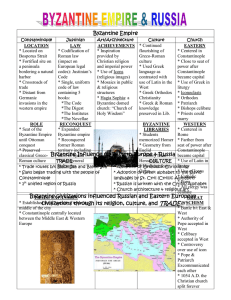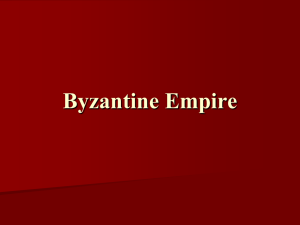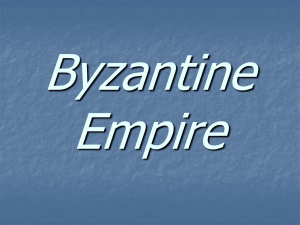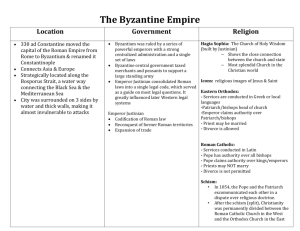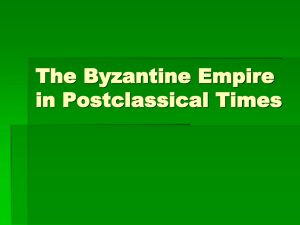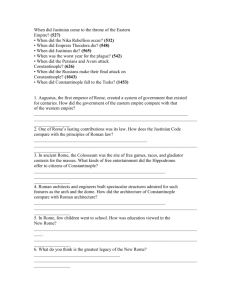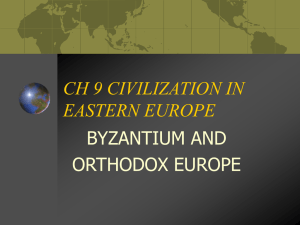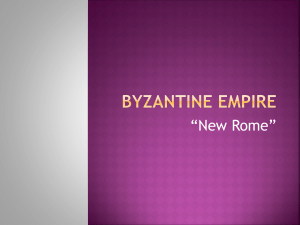File
advertisement
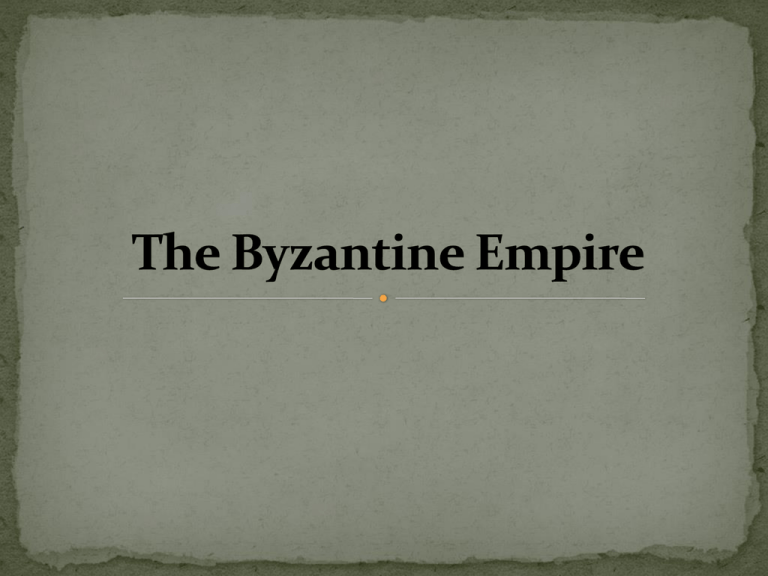
In 330, Constantine moved the capital from Rome to the Greek city, Byzantium Renames city Constantinople As the cities of the western Roman empire crumbled, Constantinople prospered With its high walls and golden domes, it stood as the proud capital of the Byzantine Empire Most famous Byzantine Emperor(527- 565 CE) Justinian is known for four main things… The code consisted of 4 works The Code- contained 5,000 Roman laws 2. The Digest- opinions of Rome’s greatest legal thinkers about the laws 3. The Institutes- a textbook explaining how to use the law 4. The Novellae- “New Law” presented legislation after 534 1. The most powerful woman in Byzantine history. Major political influence- She met with foreign leaders, passed laws and built churches Recognized the rights of women by establishing laws to protect women and gave then greater benefits in divorces. “My opinion is that now is a poor time for flight, even though it bring safety. For any man who has seen the light of day will also die, but one who has been an emperor cannot endure to be a fugitive. If now you wish to go, Emperor, nothing prevents you. There is the sea, there are the steps to the boats. But take care that after you are safe, you do not find that you would gladly exchange that safety for death.” -Empress Theodora (500-548) After Justinian’s death the empire suffered many setbacks Plague from rats on ships from India Enemies from west, north, and east side However, attacks on Constantinople by Persians, Slavs, Vikings, Arabs and other groups were largely unsuccessful … CONSTANTINOPLE’S STRONG MILITARY DEFENSE & TECHNOLOGY SAVE THE DAY On two occasions, from 674 to 677, and again in 717-18, Arab armies besieged Constantinople by land and sea. Superior military organization, the city’s high walls and its strategic location, and the timely invention of one of history's most decisive weapons, a medieval form of napalm dubbed "Greek fire“ used by the Byzantine naval fleet enabled the Byzantines to weather the storm. The cost to both sides was high. By 800 A.D., Byzantium had lost most of her territory south of the Taurus Mountains and much of the remainder of the empire lay devastated. The Arabs lost untold thousands of men through futile attacks against Constantinople's defenses. The European kingdoms finds themselves less prepared to defend against attacks until Charlemagne unifies them Pope asks Charlemagne, king of the Frankish empire, for help defending Rome In return for Charlemagne's protection the Pope names him Holy Roman Emperor in the West (800 CE) Roman Catholic Church (West) Eastern Orthodox Church (East) Capital Capital Rome Authority: pope claims authority over all kings and emperors Language Latin Church policies Priests could not marry Divorce was never allowed Idols of Jesus Christ and Saints for worship Constantinople Authority emperor claims authority over the patriarch and all other bishops Language Greek Church policies Priests can marry Divorce allowed under certain conditions No idol worship The permanent split between the Byzantine Eastern Orthodox Church and the Roman Catholic Church In 1054 the Roman Catholic Pope and the East Orthodox Patriarch excommunicated each other in a dispute over religious doctrine Schism – less connection with the west Attacks from enemies Especially the Ottoman Turks who are slowly taking over Byzantine territory (Remember: they stopped at Constantinople only because they were attacked by the Mongols on their borders.) Crusades – both sides ravage Constantinople as they pass through The weakened Constantinople could not defend itself from the rising new power in the region-the Ottoman Turkswho, by the 1300s-had completely encircled the old eastern capital. 1453 CE
